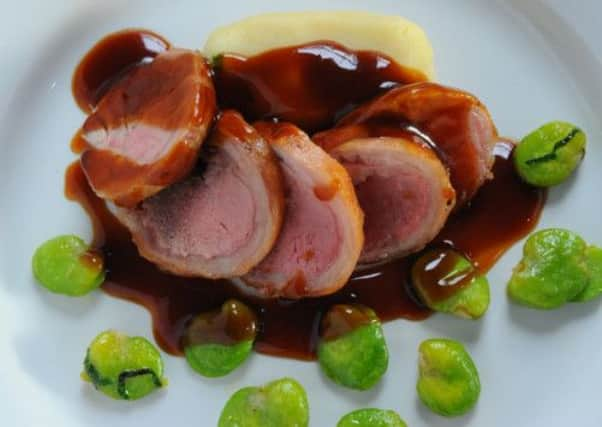Tom Kitchin: Cooking with lamb


Doing so, you can discover an incredible range of delicious dishes. You’ll get quite a different flavour cooking with a shoulder of lamb than you will with loin, for example, but the beauty is discovering your own favourite and experimenting with all the different cuts.
Don’t be afraid to try some of those forgotten cuts either, as they’re simpler to prepare than you might think. Even lamb’s tongue can be beautiful if it’s cooked properly and braised slowly. My personal favourite is rump of lamb, but I’m also a fan of Barnsley chops, especially when I eat them with kidneys and sweetbreads.
Advertisement
Hide AdAdvertisement
Hide AdWhen it comes to cooking lamb, you can try many different techniques but generally it’s recommended that, with leg or loin, roasting brings out the best flavour. Loin or loin chops are great grilled.
If you’re trying the more inexpensive cuts like shoulder, neck or lamb shanks, often the best method is braising the meat slowly. These cuts can also work well minced and can be used in homemade burgers. Shanks are one of the most popular cuts because they are relatively cheap, but when slow-cooked, the shanks almost melt in the mouth.
What makes lamb that is born, reared and slaughtered in Scotland so special is the quality of our air, water and land. Autumn lamb – found around September to November – is lamb which is born in the spring and you will find it is often more flavoursome and tender. The lamb feeds greedily on the sweet grass throughout spring and summer and by autumn it’s flavoured with the wonderful nature of its surroundings. Those extra few months are worth the wait for the superb flavour that deepens over time – the longer they graze and fatten up, the more depth of flavour you get when you cook it.
To find the best lamb, head to your local butcher or farmers’ market and chat to them about which cuts to try and how to prepare them. It’s worth looking our for the Scotch Lamb label as that guarantees quality, character and traceability. Your local butcher will stock so many more varieties and cuts of lamb than a supermarket, so visit to get exactly what you want.
Peelham Farm in Berwickshire is another great place to try. Their lamb is all organic and grass-fed on the local, coastal land, giving the meat a wonderful, natural flavour and showcasing exactly why Scotland offers some of the best lamb around.
Braised Lamb Shanks with Cumin & Flageolet Beans
Serves four
4 lamb shanks
sea salt and freshly ground black pepper
olive oil for cooking
1 onion, peeled and sliced
2 fennel bulbs, trimmed and sliced
2 garlic cloves, peeled and chopped
1 tsp fennel seeds
1 tsp ground cumin
2 tbsp tomato purée
300ml white wine
500g chopped tomatoes (full-flavoured fresh or tinned)
500ml lamb stock or chicken stock
400g tin of flageolet beans, drained (or cooked dried beans)
1 tbsp chopped parsley
bouquet garni
2 leeks, washed
handful of parsley sprigs
handful of thyme sprigs
1 bay leaf
Heat the oven to 160C/gas mark 2-3. Season the lamb shanks well all over with salt and pepper. Heat a deep, heavy-based ovenproof sauté pan (or flameproof casserole) over a medium-high heat and add a drizzle of olive oil. Brown the lamb shanks in the pan (in two batches, or one at a time if that’s easier) to colour all over. Place the browned shanks on a plate on the side.
Return the pan to a medium-low heat and add a little more oil if needed, followed by the onion, sliced fennel, garlic, fennel seeds and ground cumin.
Advertisement
Hide AdAdvertisement
Hide AdMake the bouquet garni by laying one leek leaf flat on a board, putting the herb sprigs on top and covering with the other leek leaf. Tie with kitchen string to secure and add to the pan. Sweat gently for three to four minutes. Stir in the tomato purée and cook for a further two minutes.
Pour in the white wine and let it bubble to reduce by half. Add the tomatoes and stock and bring to the boil, then stir in the flageolet beans. Replace the lamb shanks in the pan, immersing them in the tomato mixture.
Put a lid on the pan and place in the oven. Cook for one and a half hours until the meat is very soft and starting to fall from the bone.
Place a lamb shank in each warm serving bowl and spoon on the tomato and flageolet bean mixture. Sprinkle with chopped parsley to serve.
Shoulder of Lamb with Garlic, Fennel and Rosemary Roast Potatoes
Serves four
1 x 800g shoulder of lamb, boned
1 tsp ground cumin
1 tsp fennel seeds
4 sprigs fresh rosemary, chopped
3 tbsp olive oil
2 fennel bulbs
320g new potatoes
12 garlic cloves, skin on
60g butter, diced
salt and pepper
Preheat the oven to 200C/gas mark 6. Open out the lamb shoulder and cover the meat with the cumin, fennel seeds, half the rosemary, salt and pepper. Roll into a large sausage and tie with string. Heat the oil in a heavy-bottomed frying pan, add the lamb and brown until golden all over. Set aside. Cut the fennel bulbs into quarters, trimming off any loose ends, and halve the new potatoes. Put the fennel, potatoes (cut side down) and garlic cloves into an ovenproof dish and sprinkle with the rest of the rosemary and the butter. Put the lamb on top of the vegetables and roast for 35 minutes. Remove and leave to rest for 15 minutes.
To serve, remove the string from the lamb and carve the meat into thin slices. Serve with the roasted vegetables and the cooking juices.